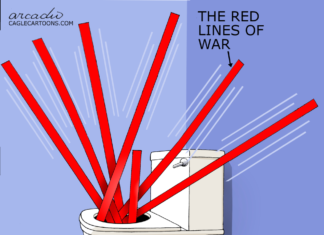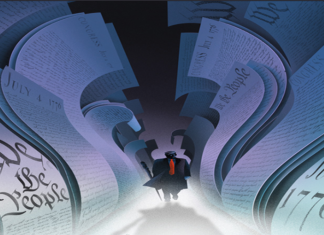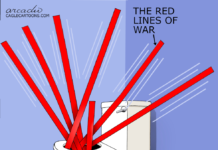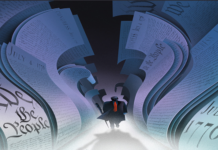A cheat sheet for reading the federal budget
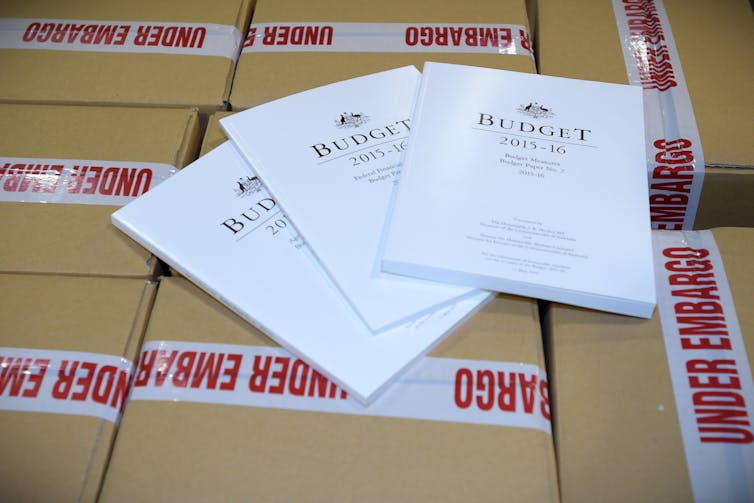
The budget papers aren’t so scary, if you know how to read them.
Lukas Coch/AAP
Phil Lewis, University of Canberra and Anne Garnett, Murdoch University
The federal budget rolls around, usually on the second week of May, every year. Last year there was over 600 pages of budget papers, pored over by politicians, journalists and lobbyists alike.
There are usually four separate budget papers, not to mention related materials such as the budget speech, overviews, ministerial statements, appropriation bills and much more.
A budget is a financial statement of the federal government’s revenues and expenditures for the next financial year and also a statement of fiscal policy proposals. However it also contains a host of proposals which may not be directly related to fiscal policy but have fiscal effects (for example increased taxes on cigarettes or cask wine may be justified on the basis of health policy but they also can be used to raise considerable revenue).
So, given we are all so time poor and would rather not wade through the hundreds of pages, what should we be looking for? Here are some ways to find things that we might want to know, or wish we didn’t know.
Is there a budget deficit, how much is it and how long until we balance the books?
The place to look is Budget Paper No. 1: Budget Strategy and Outlook, “Statement 1: Budget Overview, Table 1 – Budget Aggregates”.
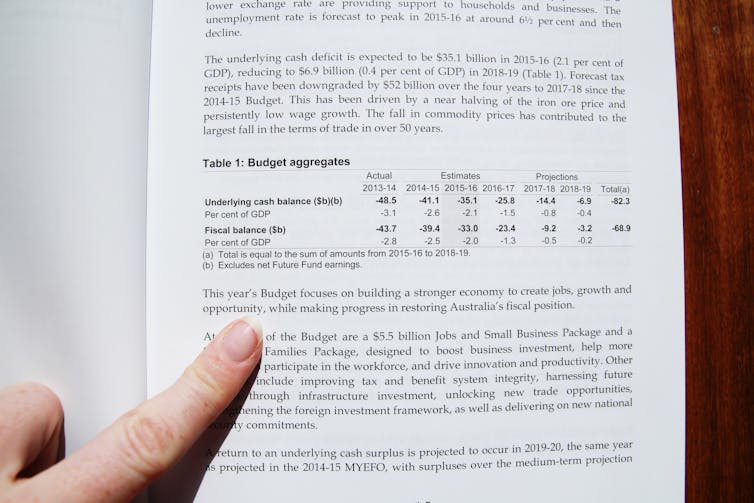
The estimated budget deficit (the excess of expenditure over revenue) for the next financial year is measured by the “Underlying Cash Balance” in A$billions. The government makes projections for a further three years – the first year is the estimate for the year of the budget, in this case for 2015/16, which is followed by budget forecasts for three more years.
If you want to show budget deficits and surpluses over time, either in A$billion, or as a percentage of gross domestic product (GDP), you can find the data for this in the last column of “Table 1: Australian Government general government sector receipts, payments, net Future Fund earnings and underlying cash balance” in Budget Paper No. 1, “Statement 10: Historical Australian Government Data”.
What about government debt?
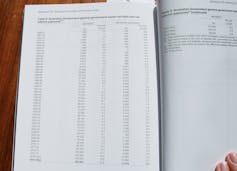
What might be of more concern than a deficit or surplus is the level of federal government debt. How fast it might be growing or shrinking and the economy’s capacity to manage it. There is no consensus about what level of debt is a problem and there are clearly differences of opinion particularly between the right and left of politics.
The Net Debt is the appropriate figure to look for. It is the sum of all government liabilities (gross debt) less government financial assets such as currency and deposits; debt securities and loans.
It’s easiest to find this by looking at the historical data in “Statement 10, Table 5”, in Budget Paper No. 1.
From here you can see the current estimated debt level in A$billions and as a percentage of GDP for the current budget, along with all past budgets and any projections (this gives a more accurate comparison of relative debt levels over time).
Where does the government get its funds from?
It gets its money from taxes – which means from us.
Specific details of which types of tax raise the most money can be found in Budget Paper No. 1, “Statement 4: Revenue, Table 7 Australian Government general government (cash) receipts”.
If you look at this in pie chart form, income tax receipts are by far the largest source of income.
Where is the money spent?
When the government spends money, where does most of it go?
The details can be found in Budget Paper No. 1, “Statement 5: Expenses and Net Capital Investment, Table 3: Estimates of expenses by function”.
For more information on the major areas where government is spending you need to look at the various tables of “Summaries of expenditure”.
For instance, in the social security and welfare category for the 2015/16 budget we can see that aged care expenditure is by far the largest category, and with an ageing population, this will grow. “Assistance to people with disabilities” is forecast to grow at the fastest rate, as the National Disability Insurance Scheme rolls out.
In a few years it will approach total spending on aged care This can be seen from the ‘Projections’ column in “Table 9: Summary of expenses — social security and welfare”.
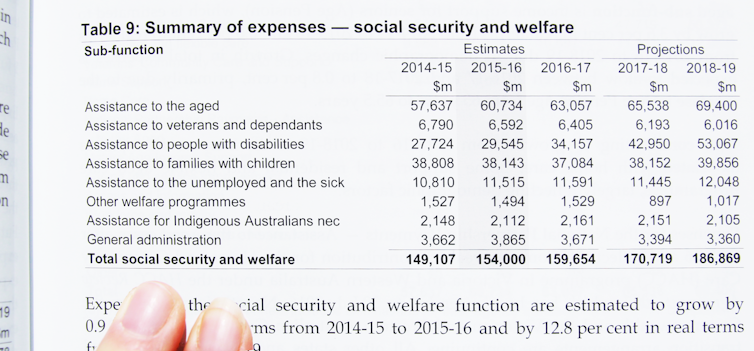
In the health summary, found in “Table 8: Summary of expenses – health”, we can see things such as how expensive Medicare is. The “medical services and benefits” category mainly consists of Medicare and Private Health Insurance Rebate expenses. Last year’s Budget also stated that Medicare expenses are the major reason for expected increases in expenditure in this category.
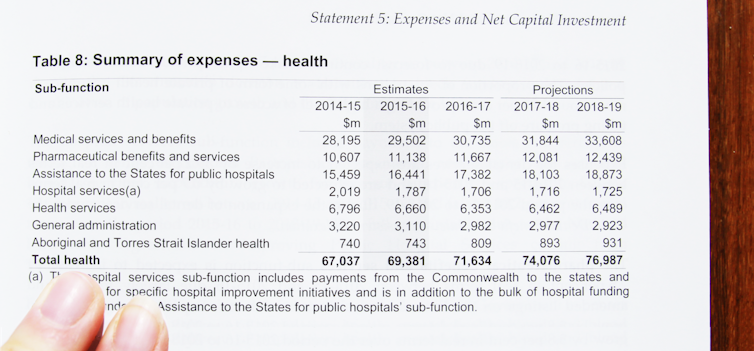
The education summary table has interesting information such as how much goes to public schools and how much to private schools. You can also see a forecast of higher education spending.
Where can we find the ‘hidden risks’ in the budget?
Since 1998 the government has been required by law under the Charter of Budget Honesty Act to have “Statement 8: Statement of Risks”. Section 8 takes some reading, but it outlines risks to the estimates in the budget.
For a more obscure example, according to the Space Activities Act (1998), the government is liable to pay for damage up to A$3 billion caused to Australians if a space object that an Australian company has launched falls out of the sky and damages something or someone (that is if damage exceeds the space object’s company’s own private insurance against such things). Now that would put a hole in budget estimates!
What if we dig a little deeper?
The Other Budget Papers – 2, 3 and 4
In case you were wondering about the other budget papers, they contain some of the nitty gritty details of the broad categories of revenue and expenditure outlined in Budget Paper No.1.
Budget Paper No. 2: Budget Measures contains the fine details of revenue and spending by government departments and government programs.
For example, it is here that in the 2015/16 budget we find that the Department of Foreign Affairs and Trade intends to substantially increase revenue from passport fees, from $1.7 million in 2015-16 to $5.4 million by 2018-19.
In this part of the 2015/16 budget papers you could also find the almost tripling of expenditure in the government’s Youth Employment Strategy Program, from $22 million in 2015-16 to $60.8 million in 2016-17.
Budget Paper No. 3: Federal Financial Relations outlines the federal relations and any payments from the commonwealth government to the state and territory governments.
You can find details of federal government payments by department (e.g. health, education), and by state and territory.
Budget Paper No. 4: Agency Resourcing may be of less interest to most people, as it provides technical details of budget resource management, including financial resources and staff resources.
But if you look closely, you can find items such as estimates of average staffing levels in federal government departments. For example, the 2015/16 budget detailed staff numbers for the the National Film and Sound Archive (237) federal government staff members, the Australian Electoral Commission (788), and the Australian Tax Office (18,482).
The budget speech
If all of this is too much, for a summary of the main policy changes, you can listen to the Treasurer’s budget speech on budget night, or read the speech transcript on the budget website.
![]() It is often quite brief and will provide the size of the budget deficit/surplus, any tax changes, new expenditure policies and new programs. But it will have political spin, so if you need to look further, hopefully this guide will help to navigate the budget papers without too much trauma.
It is often quite brief and will provide the size of the budget deficit/surplus, any tax changes, new expenditure policies and new programs. But it will have political spin, so if you need to look further, hopefully this guide will help to navigate the budget papers without too much trauma.
Phil Lewis, Professor of Economics, University of Canberra and Anne Garnett, Senior Lecturer in Economics, Murdoch University
This article was originally published on The Conversation. Read the original article.
Title
Pigsfly Newspaper Supporter
Become a Pigsfly Newspaper Supporter
Unlike many online news portals, our website doesn’t hold any annoying advertising, we don’t try and sell you anything nor have we put up a paywall – I want to keep my communiques as open and honest as I can.
Our Pigsfly Newspaper is fiercely independent and they take a fair bit of time, money and hard yakka to produce.
I want to continue delivering Pigsfly Newspaper to you.
But I need your help!
BECOME A SUPPORTER FOR $1 A MONTH
Your support is crucial to maintain the Pigsfly Newspaper
Each year Pigsfly Newspaper cover a range of topics including:
Political nonsense, spin, plain bulls**t, lies and fabrications
Lobbyists
Political donors
Gambling lobbyists and all that entails
Mining and Energy tax avoidance not in the least our continual focus on the ongoing rape of Australia’s precious resources
Tax avoidance and the industry that supports and profits
New twists on business perspectives
Old twists on political party electioneering rorts rip offs and such like
Photography
Music and
Fascinating bits and bobs you would be hard pressed to find elsewhere.
For 2018 several Pigsfly Newspaper Long Reads are planned.
On the drawing board include:
• Politicians and their “Entitlements?”
• The FUA Awards and
much much more
Your support – click below – is greatly appreciated and helps me, continue to help you.
Comments? Write to me through our Contact page
Click the button below to become a Pigsfly Newspaper Supporter for $1 a month


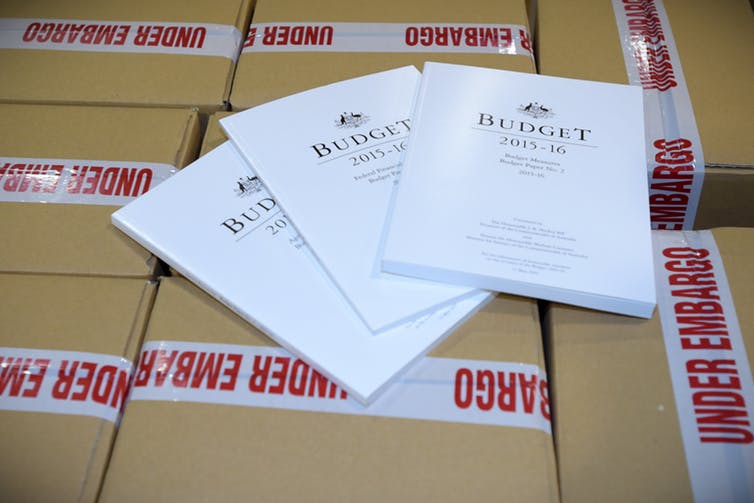







 —
—


